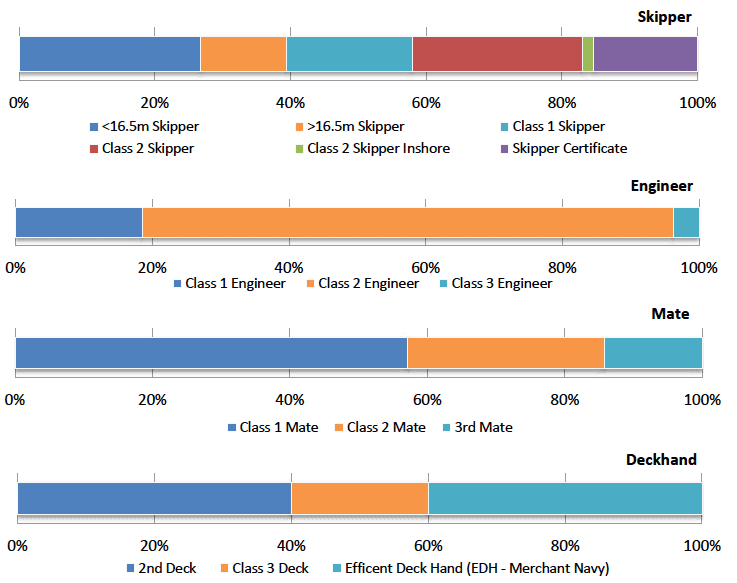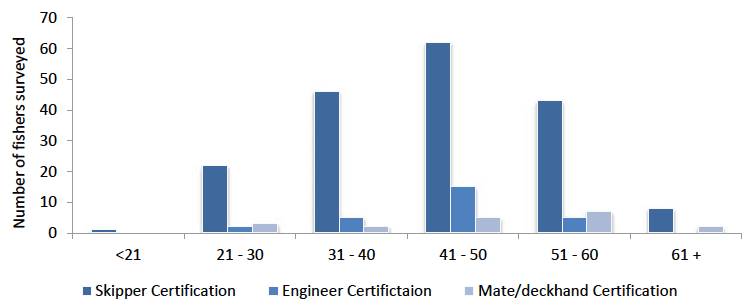Scottish Sea Fisheries Employment Report
This report details the findings of a new survey of crews on Scottish fishing vessels. It provides new information across a range of indicators such as age, nationality, job tenure and skills.
7. Qualifications
Of the 844 fishermen surveyed, 425 respondents gave details of their industry qualifications and, of those, 264 (62%) had at least one qualification above the Basic Safety Training ( BST - Sea Survival, Fire Fighting and Prevention and First Aid). The majority of certifications in the Scottish fishing industry are skippers certifications followed by engineering's and mate qualifications (Fig. 19). Deckhand certifications beyond basic training were rare, most likely because deckhand certificates beyond the BST are more common in other marine industries such as the merchant navy. Other industry based certifications were related to diving and yachting certifications (Table 17 - Annex 1).
Figure 19: Proportion of qualifications/certifications above BST by type in the Scottish fishing industry (n=425)

Figure 20: Breakdown by British, EU and non- EU respondents who hold higher qualifications than the BST ( n = 262)

Figure 21: Breakdown by British, EU and non- EU respondents who do not hold any qualifications higher that the BST ( n = 150)

Broken down by British, EU and non- EU members, over 90% of the qualifications discussed belonged to British fishers (Fig. 20), which is due to the high proportion of skippers certifications and the skipper position being held by British fishers (Fig. 7). A relatively high proportion of those who do not hold qualifications above the minimum BST are from other EU and non- EU nations (Fig. 21). This data however has to treated with caution as EU and non- EU crews members may not have been able to adequately communicate with the researchers on their other qualifications, which may also include country specific certifications unrecognised in the UK.
Figure 22: Proportion of the different types of qualification for the dominant position on a fishing vessel. This data was taken from a sample size of 232 (respondents to this question). For a full breakdown and other groups classified in figure 19 see table 17 in Annex 1.

There are five different skippers certifications and one generic group (purple bar), and the majority of skippers hold <16m, Class 1 and Class 2 skippers qualifications (Fig. 22). There are three types of engineering certifications and engineers are required on all >16.5m length vessels. In the Scottish fleet the majority hold Class 2 engineering certificates, which are required for vessels <40m in length with engines > 750kw (a minimum of 2 engineers are required on all >30m length vessels ). Class 1 are chief engineers and they are required on vessels >30m and Class 3 engineers are qualified to work on vessels 24 - 30m in length (Fishing Vessel Regulation, 1984).
Three qualifications for the position of mate were recorded in the Scottish fleet, which are also termed as deck officers, a more common term used on merchant vessels. Of the crew who hold these qualifications ( n =14), 50% of crews with a mate certification hold a Class 1 and 29% hold a Class 2. 3 rd Mate is also associated with merchant vessels and are chiefly charged with health and safety. Finally three types of deck hands qualification were recorded ( n =5), 2 nd deck and EDH as the most dominant.
Figure 23: Age profile of crew holding Skipper, Engineer and Mate/deckhand certifications

Skippers certificates are present in all age cohorts, whilst engineering certificates are present for crew aged between 21 - 60 year olds. A normal distribution for both skipper and engineers is illustrated in figure 23, suggesting new qualifications are being obtained by people working and moving through the industry. For mates and deckhand qualification this is less so, most likely because these qualifications are not required in the industry to work in these positions.
Contact
There is a problem
Thanks for your feedback